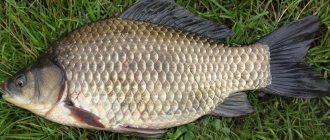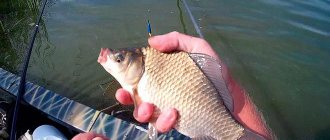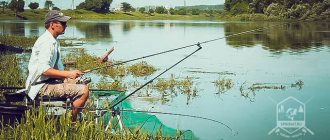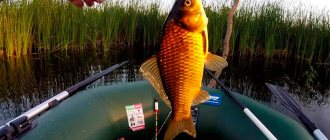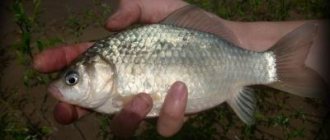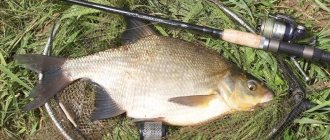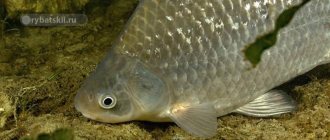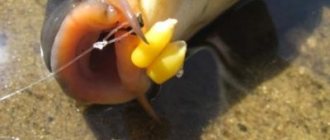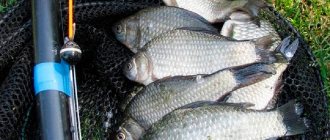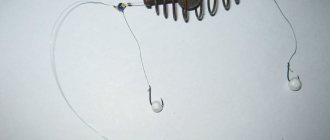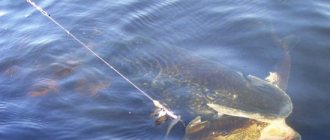All fishermen know that there is no good catch without good bait. This applies to almost any type of fish; this also applies to crucian carp and carp without any doubt. Sometimes you can sit almost the whole day and not wait for a single half-decent bite. Of course, outdoor recreation in itself is a very good thing, and getting some fresh air once again is very good. But fishermen don’t go to reservoirs for this reason, and without a catch they consider such a vacation to be incomplete. To prevent this from happening when fishing for crucian carp or crucian carp, let's learn how to prepare very good bait for these fish. You can use it now, that is, in spring, as well as in summer and autumn, in a word, take it always when you are going fishing. I am sure that the crucian carp will not be able to calmly swim past your “culinary creativity”.
How to prepare bait for carp and crucian carp?
The recipe for such bait is a little more complex than the same semolina, which is used very often when catching crucian carp. But, as they say, it’s worth tinkering with it, since you definitely won’t be left without a catch when using it. Of course, there are days when any fish (crucian carp and crucian carp, including) simply does not want to “eat” anything, no matter what we offer it, not without this. But such homemade bait will give you a better chance of a good bite than any other. It will especially please you in the summer. Now let's figure out how it can be done, and what kind of “miracle” components we need for this.
Recipe
So, we are done with the story, now we move directly to the recipe for preparing such a top dressing. For this we need sunflower seeds (or seeds, as they are also called - 300g). They will need to be fried (if not fried) and ground. We do the same with peanuts (300 g), that is, again we fry and grind. In addition, we will need semolina (a little less - 200 g), delicious bread, only fresh and gray (we take a whole loaf), any beer (also fresh and dark - 1 jar), buckwheat honey 4 tablespoons and a bag of vanilla sugar. As for buckwheat honey, if you have it candied, then you will definitely need to “convert” it into a liquid state. To do this, you will need to use a water bath, where the temperature should not exceed 60 degrees. Now all the components are at your fingertips and you can start making the bait itself.
How to do it?
Let's start with bread. We don't need the crust here, so you will need to empty the entire loaf of it. Next, divide the loaf in half. We will grind the bread. In this case, we will not need any tools, we will simply rub these halves of bread against each other. This way we will get a good pile of fairly small bread crumbs. Now add peanuts and sunflower seeds to the bread. Remember that they must be already prepared before mixing. Next, we take beer and in it we will need to dissolve several components, namely buckwheat honey plus vanilla sugar. With this beer “cocktail” we will need to thoroughly pour the dry mixture that we made from bread, peanuts and seeds. At the same time, you need to pour it carefully, and immediately mix it all well, adding small portions of our beer along the way.
As for the process of stirring such bait, this must be done carefully, that is, there is no need to squeeze it. You will be able to form balls using this squeezing and crumpling process right on the pond itself. Semolina, which will also need to be added there, will adjust the viscosity of the bait itself and its stickiness. You will determine the degree of this viscosity for yourself, based on the time that the bait will have to stay in the water and not crumble. This bait works very well with crucian carp, carp and bream. Its effect can even be enhanced if you add canned corn or peas to it. These components can be added to the bait if you put it on a hook. Happy fishing!
Here is another option for effective bait for crucian carp. How to make it and from what, you will be told in this video. Let's see.
Here's another useful video. Everything is prepared much faster here. Let's look at it too.
PS If the article was useful to you, please share it with your friends on social networks. I will be very grateful to you for this.
www.nashsovetik.ru
Now some people are just beginning, others are in the midst of the crucian carp fishing season, the beginning of the carp season is just around the corner, and for others it has already begun. In this post I would like to talk about who uses which proven recipes for preparing complementary foods for carp and crucian carp with their own hands, at home. I ask you not to post recipes here with kilograms of expensive boilies and expensive flavors - this is not for ordinary fishermen. I would like to read budget-friendly, working recipes and products that can be bought cheaply in any store. I present below one of my proven recipes for preparing bait for each of the fish in question.
These recipes came over time, trial and error.
Old carp and crucian fishermen told me something about them, and I added something along the way. Let me warn you right away that these recipes are suitable for the summer season, when the water has already warmed up normally and plant food for fish will be relevant. In central Russia this is the period from late May to mid-September. And so, let's go... Feeding for carp.
Ingredients: 30% - Whole grain corn 20% - whole grain peas 20% - pearl barley 10% - crushed corn (either millet or barley grits) 10% - oil cake 10% - purchased flavored bait All components except the third and I usually buy the latter at the local poultry market in 10-liter buckets. Firstly, it’s cheap, and secondly, all the grains there are unprocessed, which means they retain more of their original properties and aromas. Whole corn - 100 rub. bucket, peas - 120 rub. bucket, crushed grain - 80-100 rubles bucket, cake - 120 rubles. bucket. First you need to prepare the porridge, which will be the basis of the bait. Usually I take a 10-liter saucepan, fill it with water, not 3 fingers full, and put it on the gas stove. Immediately pour the whole corn into cold water. When the corn comes to a boil, I add the peas, as they cook a little faster. I simmer these 2 grains until they begin to swell a little, after that I add pearl barley and cook until the desired condition, until all 3 grains swell (the main thing is not to overcook). Lastly, I add crushed corn, or barley, or millet, depending on what is available, while constantly stirring so that it does not burn - small particles must be present so that the complementary food is not too crumbly. If all proportions are chosen correctly, after 1-2 minutes the porridge will become quite thick, there will be no more than 1 cm of water on top, and upon further cooling the pan will be full. Turn off the heat and cover with a lid; the remaining water will be absorbed by the cereal. I can’t say how much of something in grams, now I add everything by eye. Approximately 700-800 grams are needed for 1 pan. corn, 500 - 600 gr. peas, the same amount of pearl barley, 300-400 gr. crushed pieces. All these grams increase later after cooking. At the pond, I dump the porridge that has cooled overnight into a container, add the cake and a pack (800 g - 1 kg) of purchased flavored bait. For the last 2 years I have been using bait from the “Extra” series, which I always buy from the same store. This is carpomaniya.ru/cat/?product=3. Carp may prefer different flavors in each body of water, but in most cases Tutti Frutti, Honey and Chocolate work best for me. This bait gives the whole mixture a wonderful aroma and color that makes you want to eat it yourself. This recipe really works and many amateur carp anglers have already adopted it from me. Taking into account the fact that in a 10-liter pan the porridge is in a compressed form, after loosening it and mixing it with cake and purchased bait, an almost full 15-liter container is obtained. It usually lasts me all day. Here is a view of the finished bait.
I also use fishing corn as bait; in the last 2 seasons it has shown itself to be excellent in comparison with several other competitors, and in practice it is many times more catchy than the traditional “Bonduelle” from the grocery store. This is the corn carpomaniya.ru/cat/index.php?product=53. As for the aromas, “Tutti-frutti” works best for me, but sometimes “Honey” or “Strawberry” works better. I usually carry and wear all 3 of these scents with me. After fishing, this corn is perfectly stored in the refrigerator in a preservative and does not disappear for a very long time. Along with 1-2 grains, I usually put 2-3 maggots or a dung worm on the hook, depending on where I get it best. Below, to break up the text, are some photos of what I have caught in the last 3-4 years with this corn, using my own complementary feeding recipe:
Complementary feeding for crucian carp.
40% - Pearl barley 20% - Half peas (grains divided in half) 10% - Barley grits or crushed corn 10% - Rolled oats 10% - Cake (cake) 10% - purchased flavored bait Here again in the store I only take pearl barley, rolled oats and purchased bait, the rest at the poultry market.
If the crucian carp is not large, then I replace the peas with wheat bran.
In the same way as for carp, I cook porridge for the base, adding ingredients in the following sequence: 1. Peas (in cold water), 2 Barley (as the peas begin to swell), 3 Barley or crushed barley (before cooking). On a pond, as with carp, I add cake and half a pack of purchased bait to the porridge, and, if possible, chopped worms. I also take complementary foods “Carpomaniya”, if there is one: carpomaniya.ru/cat/images/bg/mf/master_6.jpg, if not, then also from the “Extra” series, although crucian carp prefers slightly different flavors, namely “Hemp” ", "Anise", "Peas". In terms of volume, crucian carp need less bait, especially if I fish not with a feeder, but with a float, so I often make do with a 7-liter pan of porridge, from which, after adding the other components, I get 10 liters of bait. Well, in the end, some results on crucian carp fishing: I’ll probably also add my recipe for complementary feeding for roach. This recipe works for me primarily in ponds with standing water.
Recipe for complementary feeding for roach.
30% - Millet.
20% - Wheat bran (breadcrumbs are even better) 15% - Pearl barley 15% - Crushed barley 10% - cake 10% - Purchased flavored groundbait Here, in the same way, first porridge from pearl barley and millet is cooked. If you don’t have purchased bait, then at the end of cooking it will be very useful to add 1-2 bags of vanillin to the porridge, and replace the part that is put on the purchased bait with breadcrumbs.
Vanilla is probably the favorite scent for roaches. At the reservoir, bran (or crackers), cake, and purchased complementary foods with flavoring are added to the millet and pearl barley porridge. My progress on roach is shown in the photo below. I catch roach less often than crucian carp and crucian carp, which is why there are fewer photos. As you can see from the last photo, there is a perch along with the roach. This is not uncommon. Roach bait consists mainly of small particles, except pearl barley, and it collects a lot of small things; a decent perch begins to chase the small things and often grabs a hook with bait. About 3 years ago I also caught roach on the feeder, mostly not large ones, up to 100 grams, and then a trophy perch sat on the hook, which later pulled in 800 grams. It was a pleasure to pull him on a rig with a leader using a #14 hook.
www.drive2.ru
How to make bait for carp at home
Each fisherman has his own treasured feeding recipes. They differ in composition and working qualities, but the basic rules for preparing bait remain the same:
- The basis of any bait is cereal ingredients or cereals. Carp also loves peas, corn, and oats.
- Fine components should be used in mixtures. They create dust in the water and do not allow the fish to get enough.
- Carp loves aromatic food, so the use of flavorings and attractants is mandatory.
- You should add components similar to the bait used in the feed.
All ingredients must be fresh. They are prepared in the evening and mixed in the morning at the pond.
Recipe for the feeder
The simplest recipe:
- Soak peas and pearl barley in a 2:1 ratio in water for several hours. Then boil them over medium heat.
- Cook millet and corn porridge in a 1:1 ratio in another pan.
- We pre-soak a kilogram of wheat for 12 hours, and then also cook it in a separate bowl.
- Mix all the cooked cereals in one container.
Arriving at the pond, add flavorings and breadcrumbs. You can use pellets or a store-bought mixture.
Complementary foods for different seasons
Depending on the time of year, the composition of carp bait changes. The preferences of fish are influenced by weather, water temperature, and food supply. These factors must be taken into account when preparing for your upcoming fishing trip. Experienced carp fishermen use different food recipes.
For spring
The task of spring bait comes down to awakening the appetite of passive fish, forcing it to approach the feeding point and take the bait. A mixture of available ingredients works well:
- In a 1:1 ratio, pour peas, corn porridge, wheat and millet into a saucepan with boiling water.
- Cook until done, stirring constantly.
- At the end of cooking, add 150–200 grams of sugar to the resulting porridge, cover with a lid and leave to cool.
- At the pond, add some aromatic black bread and garlic to the mixture.
- We use cake or semolina as a leavening agent.
We recommend reading: Carolina spinning equipment
Since in spring carp needs an increased amount of protein, we add bloodworms or finely chopped worms to the bait.
For summer
In summer, carp often go to shallow water, stay in the upper horizon, and prefer sweet smells. Here is a well-proven mixture recipe that even a novice angler can implement:
- Mix egg powder, soy flour and milk powder in a ratio of 1:2:3.
- Add breadcrumbs to the mixture.
- We use sugar and honey and a little cinnamon as flavorings and sweeteners.
We finally prepare the bait on the shore.
For autumn
In autumn, the requirements for carp bait are similar to those in spring. Carp needs an increased amount of protein, is often passive, feeds on exits, stays at medium and great depths, and moves little. A good recipe that experienced anglers like:
- Pour boiling water over the pearl barley and let it brew for about two hours.
- Mix bran, raisins, chopped peanuts, honey and also pour boiling water for half an hour.
- At the pond, add a pinch of bloodworms or chopped worms to the complementary food.
It is advisable to add a little soil to the mixture. We take water directly from the reservoir.
For winter
In winter, carp bait should not be greasy. It is based on animal components and soil. The simplest way to prepare the mixture:
- Mix the soil with bloodworms and chopped worms.
- Add breadcrumbs or milk powder.
- It is useful to add hemp, flax or poppy seeds.
In winter, you should not get carried away with attractants, so as not to scare the fish away from the fishing zone.
The advantage of our bait recipe for crucian carp
Garlic is one of the best flavorings for feeding crucian carp
- There are odorous fractions that very quickly collect crucian carp in the fishing zone, even in stagnant water.
- The cereal grains are quite appetizing and are rated much higher among crucian carp, so you can be sure that the crucian carp will not leave the fishing zone too quickly.
- The overall color of the bait will be dark or pale in color and will not allow the fish to be afraid of the bright white spot on the bottom (this is exactly what happened if we used just a mixture of millet and rice).
- The bait does not need to be aromatized; the components of the purchased mixture are already equipped with the necessary aromatic properties.
- Very low price and availability of ingredients.
The importance of bait in carp fishing
Feeding the carp allows you to attract the fish to the desired point so that it quickly finds the bait. A mixture selected according to taste and aroma is capable of collecting many individuals and keeping them in the desired area for a long time, which increases the likelihood and number of bites.
In addition, by choosing the color of the bait to match the ground, the angler can create a contrasting spot on the bottom that will stand out against the general background. This will also have a positive effect on attracting fish to the fishing point, making it easier to find the bait and allowing it to be kept there throughout the entire fishing period.
Make or buy
All baits for carp can be divided into homemade and factory-made. The recipes of the former have been known for a long time; they were used by our grandfathers and great-grandfathers, but even today they remain quite effective. The latter were developed by professional fishermen, their production has been put on stream and you can buy ready-made mixtures in every fishing store.
Top 5 ready-made baits for carp
Factory-made carp baits make life much easier for fishermen. With them, you don't have to stand in the kitchen the whole evening before leaving to prepare the mixture. It is enough to take with you the required number of bags of food, mix them in a pond and send them into the water.
However, not all store-bought baits work equally well for carp. Top 5 mixtures that can be recommended to anglers:
- Dunaev Premium Carp-Sazan;
- Traper Big Karp Vanillas;
- Sensas 3000 Super River Carp;
- Minenko PMbaits Carp;
- VDE Carp.
Each rating model is balanced in composition, designed for certain fishing conditions and time of year.
Advantages and disadvantages of homemade mixtures
Do-it-yourself bait allows you to save money while getting a working mixture. The fisherman can choose its composition, independently selecting the optimal components for the given fishing conditions, fish activity, and weather factors.
Recommended reading: The best silicone baits for pike perch
On a note! All professional carp anglers know how to prepare their own bait and specifically select components for fishing conditions.
The main disadvantage of homemade food is the length of time it takes to prepare. The fisherman needs to spend the whole evening before going to the pond to prepare all the components of the mixture. You also need to ensure that the product does not deteriorate, otherwise fishing will be ineffective.
Recipe
Stage No. 1
- Fill the pan with cold water and put it on fire.
- After the water has boiled, add 2 tea mugs of millet (the cheapest and most catchable grain for crucian carp).
- 1 mug of semolina (for better adhesion).
- 1 mug of pearl barley (cheap filler).
- Drain the water to a level 1 cm above the cereal.
- Cook for 30 minutes. Stir the mixture as it cooks to prevent it from sticking to the bottom of the pan.
- After 30 minutes of cooking, completely drain the water through a sieve. Be careful, touching the hot mixture with your hands is problematic even after 20-30 minutes of cooling. Only the surface cools down, but inside it remains hot for a very long time. You can cool the bait mixture by placing it in a small saucepan, and place the pan itself in a container with cold water, but do not allow the water to get on the bait.
- After the bait has completely cooled, you can add the following ingredients.
- 1 cup breadcrumbs (to make it more crumbly and create a haze)
- 1 cup of sunflower cake (a very important ingredient, since crucian carp are crazy about the smell of the seeds).
This is only the first step , at which many can stop, and even now the attractiveness of bait is very high, but it can be increased in two more ways:
Stage No. 2
- Add flavoring drops (garlic, anise, cake, hemp, dill, strawberry, vanilla).
- Add 1-2 mugs of commercial bait with the smell of seeds, vanilla, hemp.
Of course, you may not have some of the ingredients on hand, but you can also substitute some of the ingredients with your own. We will be glad to hear your feedback and experiments with hooking crucian carp.
How to catch crucian carp with a float rod - choosing bait, bait, correct fishing technique and finding a place to catch crucian carp.
Fishing for crucian carp on a feeder - the most detailed Russian-language guide to feeder fishing for crucian carp: finding a fishing spot, the correct tackle and rigging, bait and groundbait.How to choose the right fishing line for fishing - braided or monofilament, or maybe fluorocarbon?
Features of bait for crucian carp
In addition to the fact that it is recommended to feed a few days before fishing, there are other features of bait for crucian carp. A good catch is influenced by seasonality, mixture composition and flavorings.
Seasonality
It is worth considering in more detail the rules of baiting separately for each season:
- In winter. Fishing for these trophies during this period is considered relatively unpredictable. In some reservoirs, crucian carp are active at the beginning and at the end of freeze-up, in others the situation is more positive. In winter, small crucian carp necessarily burrow into the silt, while larger ones continue to swim, but are inactive. That’s why fishermen catch more large trophies in winter. If there are actively predatory fish at depth differences and in the thicket area, then there are also peaceful fish there, including crucian carp. It is sensitive to atmospheric pressure, and is active on calm, sunny days. Slightly active ones are used as flavoring agents. The bait can be of protein or vegetable origin. If there are no branded baits, you can use traditional mixtures of breadcrumbs, cakes, various cereals in combination with maggots or food bloodworms. In winter, it is important not to overdo it with complementary foods, otherwise the fish will quickly become full.
- In the spring. During this period, fishermen take into account that crucian carp are hungry after the winter cold. Accordingly, they are more active in feeding. Experienced fishermen use worms, maggots or even bloodworms as bait. Since April, this species of peaceful fish has been biting on dough, or its combination with worms. Bloodworms will not bring any benefit during this period, since there will already be a lot of them in the reservoir in April. At the end of May, it is advisable to use pearl barley or other bait of plant origin. You can combine 100 g of semolina porridge with 500 g of flour, water and sunflower oil, kneading the dough from these components and adding flavoring and chopped worms and maggots. This bait is thrown in 1.5-2 hours before fishing.
- In summer. Experienced fishermen have noticed that in summer it is better to use large baits, which are carefully steamed pearl barley, dung worms or sweet corn. Large crucian carp pay attention to the size not of the hook, but of the bait. The larger it is, the better. In summer, the thickness of the fishing line also plays an important role - it should be about 0.12-0.14 mm. The correct composition of bait during this period is especially important. It should both reduce pressure from small fish and increase the likelihood of large fish biting. As feeder bait, you can mix 2 parts of breading with 2 parts of ground sunflower cake and 1 part of ground grain, steamed cereal and chopped worms. You can add honey or vanillin as an aromatic additive.
- In autumn. The water temperature during this period gradually decreases, as does the activity of crucian carp. In reservoirs where there is a lot of silt, catching crucian carp becomes pointless, since it begins to bury itself in the silt. The situation is more favorable in places with strong currents. A rich catch will be obtained only if there is a well-balanced bait. It must be predominantly of animal origin. It is important to take into account that the cooler the weather, the more actively the crucian carp will go to depth. On warm days it goes out onto the sandbank. Also in the fall, it does not move at night, so it is fed only during the day in order to increase the chance of catching a large trophy.
Components in the mixture
The next thing to pay attention to is the components in the mixture. Since the conditions for catching crucian carp vary depending on the time of year and weather conditions, either dry mixture or dough and porridge are used as bait.
For dry mixtures use:
- breadcrumbs;
- self-ground crackers;
- ready-made store-bought base mixture.
You can buy a basic carp mixture in the store. But as natural flavorings, those purchased at the grocery store are used (dill, vanillin, honey, cumin, etc.).
Some experienced fishermen make mixtures from animal feed. Bait components are also used as bait, adding them to the porridge or mixture.
Flavors
Crucian carp is a very picky fish about smells. The right combination of bait and flavorings will give the fish the proper appetite. Attractants, unlike flavoring agents, interest crucian carp without causing appetite. Flavorings also have an advantage over activators: they will remain active until the end of fishing.
What flavorings are great:
- Vanillin. Moreover, not only small and medium-sized crucian carp bite on it, but also bream.
- Anise. A few drops of this ingredient are added to semolina or bread. But in winter it is used extremely carefully, or not added at all.
- Garlic. This is a favorite flavoring for large trophies.
- Honey. It is not always highly effective, but there are periods when this type of fish actively bites on semolina with honey.
- Hemp. Effective for weak bites.
- Dill. It is considered the best among all flavorings for catching crucian carp in the wild.
- Potato chips. An excellent bait for carp, but small crucian carp also actively react to it.
DIY plant baits for crucian carp
Baits for crucian carp of plant origin are no less relevant than animal baits, and in some periods of the year, this is especially noticeable in the summer season in warm water, crucian carp give preference to the plant composition. In the natural environment, fish feed on cereal seeds that fall into the water, and also love young growth of aquatic vegetation. Fishermen, based on these preferences of crucian carp, prepare various types of baits, mixing plant compositions and adding all kinds of attractants to them. Our further conversation will focus on the most effective plant baits, which are quite easy to prepare with your own hands.
Mastyrka

Mastyrka is a mixture prepared on the basis of pea porridge. It is popular during the summer fishing period. During the cooking process, a sticky substance is obtained, which is placed on the hook in the form of balls, covering the sting. The disadvantage of the mixture is that it quickly gets wet in water, as a result of which you have to frequently change the bait, preventing it from completely slipping. When frozen, mastyrka can be stored for up to six months.
The freshly prepared composition is used within 24 hours. To prepare mastyrka, you will need the following ingredients: peas, which are soaked and subsequently boiled and pounded into puree, semolina, which is added to the pea porridge during cooking, as well as a small amount of sunflower oil to give the mixture a specific smell.
Semolina chatter
Semolina is not difficult to prepare either. This type of bait is used for crucian carp fishing in the summer. To make the bait, you will need semolina and water, which, after a couple of hours of infusion together, are stirred until a viscous plastic mass is obtained. All sorts of promising aromatic additives for the fishing area add to the effectiveness of the mixed fish. The mixture is charged into a syringe, through which the bait is mounted on the hook of the tackle. Unused mash is frozen and stored for up to six months with subsequent use.
Dough
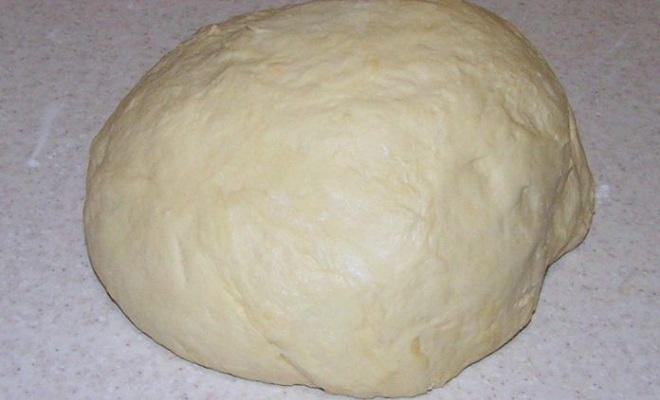
Bait for crucian carp in the form of dough is widely used in fishing from mid-spring until the autumn cold snap. The easiest way to prepare dough is with wheat flour by diluting it with water and adding breadcrumbs or crushed cookies. The bait can be prepared directly on the shore of the reservoir, mixed with so-called local water. The dough has a short shelf life and a high degree of fluidity in water, which complicates fishing due to frequent losses of bait due to poor casting.
To improve the quality of fastening the dough on the hooks, fishermen use installing a spring on the shank of the hook or adding cotton wool to the mixed bait, which reduces the fluidity properties of the mixed bait. As a rule, a portion of dough is prepared for one fishing trip, without freezing to preserve the composition.
Pea bait
Crucian carp, like many other fish from the carp family, loves bait made from peas. For baits, dry pea grains are used, which are steamed or boiled. Depending on the size of the trophy planned in the catches, the grain size is selected. One of the nuances of proper preparation of peas is their heat treatment to a state that allows the grain to remain intact, but not crack or wrinkle when placed on a hook. Pea grain is often used as a component of a hair rig that replaces a boilie. In addition to preparing bait at home, you can purchase canned sweet peas and use them for crucian carp fishing without any modifications. Crucian carp are caught using peas from May until Indian summer, which usually begins in September.
How to make bread bait for crucian carp
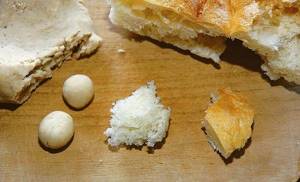
The best bait for pond carp in the summer is a bread pellet. Both rye and wheat fresh bread are suitable for preparing the nozzle. To form a pellet, take the bread crumb and crush it until a plastic dense mass is obtained. In this kind of bait it is appropriate to add a couple of drops of an attractant, the scent preferred by the fish. Depending on the size of the trophy, pellets are prepared in different volumes. To attach the bread crumb, hooks with a short shank are used.
Mamalyga for crucian carp
In some ponds and reservoirs, in the spring and very beginning of summer, there is an active bite of crucian carp on hominy or porridge cooked with corn flour. This aromatic and bright-colored bait in the crucian version is cooked with the addition of wheat flour to ground corn, which helps to increase the density of the porridge, thereby better holding the bait on the hook. In most cases, no attractants are added to the porridge, limiting itself only to sweetening it with a small amount of sugar. Mamalyga is rolled into balls and served to fish in this form. A certain portion of hominy is prepared for fishing, with no prospects for long-term use.
Boiled corn
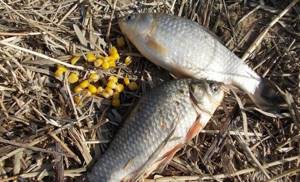
You can make bait that is attractive in appearance and taste from corn grains. Cooking corn is similar to preparing peas for bait. Particular attention is paid to the choice of corn grain. Crucian carp does not like grains of angular shapes, preferring more rounded, medium-sized seed samples. The selected material is steamed or boiled until partially cooked, adding sugar or natural honey during cooking. The finished grain is used as a direct bait on a hook or in a combination of hair equipment. Canned sweet corn is used in sandwiches, combined with animal baits.
Comparison of store-bought and homemade bait
Opinions vary greatly on which bait to prefer: store-bought or home-made. That is why you should consider the positive and negative aspects of each method.
Advantages and disadvantages
Mastyrka, mash and semolina are often used as bait.
| Pros and cons of self-made bait | ||
| Lure | pros | Minuses |
| Chatterbox | Quick cooking | Applicable only in standing water conditions |
| Mastyrka | Active bite | When cooking, stir constantly until the mixture becomes dry. |
| Semolina | There are several of them:
| These include:
|
Store-bought bait also has positive properties, but is not without its drawbacks:
| Store-bought mixtures for crucian carp | |
| pros | Minuses |
| Because they are made by true professionals, the mixtures concentrate only the most necessary components in the right parts. Advanced developments are used in the use of synthetic substances that have a strong effect on the olfactory and taste receptors of crucian carp. The composition of the mixtures is strictly controlled, so the fisherman always knows how much it will be needed for fishing. | Unlike a store-bought mixture, when prepared, the fisherman, conducting his experiments, better understands the taste preferences of crucian carp in a certain place in the reservoir. In addition, with a strong dependence on store-bought bait, the fisherman’s independence is reduced, and constant purchases can hit the pocket. And sometimes expensive amino acids do not affect the catch, but have a significant impact on the final cost. |
What to prefer?
Store-bought mixture is preferred if the fisherman:
- does not know the characteristics of the local reservoir and the behavior of fish;
- believes that the mixture recipe developed by professionals will be more effective, in contrast to his own preferences;
- does not know how to create a balanced bait;
- no time to cook.
But with all this, fishermen understand that universal bait cannot take into account the nutritional characteristics of crucian carp in a certain body of water, especially if it is located in the area of a village or village.
Store-bought bait
Experts have developed special formulations that should attract large numbers of crucian carp. But the use of such mixtures is not always wise. For example, if unfavorable conditions arise (drying out or hypothermia of the reservoir), crucian carp burrows into a layer of silt, and fishing at this time may be unsuccessful, regardless of the chosen complementary food for crucian carp.
In stores you can find a lot of different baits, one of which is Traper bait, which works on crucian carp, bream, and roach.
Recipes for making homemade bait for crucian carp
There are several common recipes for homemade bait for crucian carp:
- For preparation you will need: a bag of breadcrumbs, 200 g of seeds, 0.5 kg of oatmeal porridge and a pack of cookies. Everything is mixed, flavoring is added, and for the density and viscosity of the mixture, river sand or clay is added.
- Ingredients: millet, ground or bread crumbs, corn flour, fried rolled oats, flavoring and, if you catch crucian carp in cold weather, chopped worms or bloodworms. The proportions of all ingredients depend on the weather, season, body of water and other factors.
- Ingredients: roasted ground flour, millet and water. Preparation procedure: half a liter of water is brought to a boil in a small saucepan, millet is poured into it, and cooked until the liquid boils away. Then add the flour, stirring thoroughly. It is important to consider that the more of this ingredient you add, the more crumbly the porridge will turn out. Therefore, to maintain the viscosity and stickiness of the porridge, only half a glass of flour is enough.
- Ingredients: seeds, peas, millet, water, breadcrumbs. Boil water in a saucepan, then add peas. It is poured first because it takes longer to cook than millet. After boiling it for 15 minutes, add millet for the same time, making sure that this grain does not boil, otherwise the porridge will be excessively viscous. During cooking, grind the seeds and mix them with breadcrumbs. The approximate ratio of ingredients is 1 to 1. This bait attracts not only crucian carp, but also carp, roach and other peaceful fish.
Tips for using bait for crucian carp
Experienced fishermen give the following practical advice:
- Feeder fishing is possible both in still water and in the current. The bait products should be easily released, forming a kind of cloud of small particles around them.
- If there is no desire to constantly change the bait, as in the case of feeder fishing, it is done with a ring, but fishing will only be effective in strong currents. But the viscosity of the bait is much higher.
- If you fish with dry mixtures in the summer, it is advisable to use strawberries as a flavoring agent. In winter it is better to use garlic.
- When preparing mixtures with cake, it must be fragrant. The market one is unlikely to be suitable due to the fact that it is already empty. Flavorings are added last.
- You need to feed the crucian carp without oversaturating it, otherwise there will be no bite.
Reviews from fishermen about bait
Among all the reviews from fishermen about bait, you can consider the following:
To summarize, it should be noted that despite the narrow list of ingredients for creating bait, the fisherman can experiment without restrictions.
According to the studied recipes, he can add other components to the composition, or change the ratio of those available, depending on the specific fishing conditions. Developing the most suitable mixture recipe is the key to a successful catch.
bagorik.ru
Store-bought bait versus homemade bait: which to choose?
If you plan to fish for crucian carp or crucian carp, what bait is best to use? Most experts are of the following opinion: if the fishing takes place in a proven place, you can use homemade mixtures, but if the choice falls on an unfamiliar body of water, it is recommended to give preference to a purchased mixture.
This recommendation is due to certain advantages of purchased mixtures:
- When developing the optimal recipe, manufacturers rely on numerous recommendations and studies by ichthyologists about the preferences of fish. This is why store-bought complementary foods are considered perfectly balanced and most attractive to fish;
- store-bought mixtures are moistened in a special way, thanks to which they have an optimal consistency and muddy the water well. Because of this structure, the fish senses the smell from a great distance;
- purchasing food can significantly save the fisherman’s time, without having to look for suitable ingredients and stand at the stove.
The undoubted advantage of purchased gruels is that they are more than affordable and every person, regardless of income, can easily purchase them.
The only drawback is that universal mixtures are designed for the average fish, but their preparation does not take into account the nutritional characteristics of crucian carp in a particular body of water. As practice shows, fish living in lakes and rivers located near villages can be quite picky about food.
What bait does he use in the summer?
During this period, focus on plant species. Throughout the summer you can try everything listed above. In different bodies of water, crucian carp have their own tastes, which may differ radically from the neighboring river. But still, their common desires coincide:
- Semolina
- Pearl barley
- Peas
- Corn
- Dough
It’s impossible to say what exactly will be relevant on the day of fishing, so always take as many baits with you as possible. Don’t forget about the worm: if there’s no bite at all, try to radically change tactics by putting in something meaty. Sandwiches using several ingredients at once are considered no less attractive. The most difficult thing is to fish in an unfamiliar body of water, where nothing is known. When you visit the same places year after year, you remember the places, depths and baits that caught well. We recommend garlic, honey and anise as attractants.
Main Ingredients
In order for the “Best” bait for crucian carp to live up to its name, you need not only to follow the rules for its preparation, but also to be able to correctly combine the ingredients.
The most effective and efficient will be a gruel that includes the following components:
- millet;
- chopped oatmeal;
- semolina;
- cake;
- crushed cookies and dry bread crumbs.
Experienced fishermen also note, given the specific nutrition of carp and crucian carp, the smaller the contents of the bait, the better. This type of fish, both small and large individuals, react very well to “crumbs”, so you should not be afraid to overdo it with crushing.
You can also use powdered milk and egg powder as a special additive; fish of the cyprinid genus will definitely not ignore such a treat.
Most popular recipes
Despite the fact that today you can find a lot of options for preparing bait on the Internet, finding a recipe for bait for crucian carp that will work properly may not be so easy. But the following feeders for carp and crucian carp, tested by more than one generation of fishermen, have proven themselves very well.
Recipe No. 1. Preparation of a dry combined mixture.
- Wheat grains and barley are used as the basis. They must be taken in equal quantities (1 kg each), mixed and crushed properly. Then add 500 g of chopped corn to the resulting mixture.
- Add 250 g of semolina, cake and corn flour to the resulting powder.
- The ingredients are mixed again.
- Finally, what you receive must be packaged in bags.
Before fishing, this powder will need to be soaked; it is better to do this using ordinary water. When the consistency of the bait is suitable, small balls are formed from it and thrown into the water (they should be approximately the size of a small tangerine).
Recipe No. 2. This bait is prepared in a completely different way, but is also very catchy.
- First you need to mix together 500 g of ground crackers (preferably the bread is white), sunflower seeds and bran.
- To the resulting mixture add a little granulated sugar (4 teaspoons) and 3 pinches of vanillin. If vanillin is not on hand, it can be replaced with dill or garlic. It is recommended to use river sand as a leavening agent.
If fishing will be carried out using a spring, it is necessary to take into account that bait for crucian carp on a spring is prepared taking into account certain features.
Mixture requirements
For successful fishing, you need to choose the right food, taking into account various factors. The main ones are the characteristics of the reservoir, the time of year, the preferences of the local underwater inhabitants and the weather. The mixture must be balanced and have certain working properties.
Any carp bait includes:
- basic components;
- binders and disintegrants;
- flavorings;
- bite activators;
- animal supplements.
An experienced fisherman skillfully combines ingredients, obtaining working and effective compositions.
Basic components
The following can be used as a feed base:
- porridge or cereals;
- grains;
- pellets;
- dry mixes;
- boilies.
A combination of these ingredients is often used. Many homemade baits contain grains of wheat, barley, millet, and crushed sunflower seeds. Carp also loves corn, so its use in different forms is justified.
Binders and disintegrants
In order for complementary food to have the correct consistency, not break when hitting water and begin to disintegrate at the bottom, forming an attractive spot, it is necessary to add binding and loosening components to it. Without them, it is impossible to obtain a high-quality working mixture.
Leavening agents include bread crumbs, bran, cake and milk powder. Breading, as a rule, is added to all bait mixtures. Falling to the bottom, the ball of food begins to “dust”, creating a cloud of turbidity, which can attract carp from a long distance.
Tip: Bread crumbs or bone and krill meal are also used as a leavening agent.
Of the binding components, “Hercules” is often used. Its amount in the mixture depends on the fishing conditions - the presence and strength of the current, depth, relief. The deeper at the fishing point and the more powerful the water flow, the more oatmeal should be added to the bait.
We recommend reading: The most catchy wobblers for asp
Aromatic additives depending on water temperature
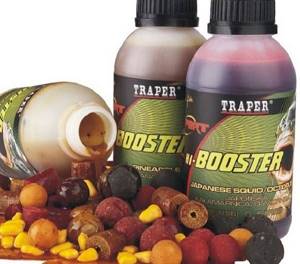
Bait for carp fishing should contain aromatics, which increases its effectiveness and range of action. In warm water, sweet and fruity smells are relevant - raspberry, vanilla, honey, cinnamon. In early spring, late autumn and winter, garlic, anise, dill, and animal protein are used.
Bite activators
This component allows you to significantly increase the number of fish bites. Recently, carp fishermen have been adding various factory-made attractants with pheromones to their complementary food, which can stimulate the activity of carp, even during hours of complete non-biting.
Animal supplements
From living components, small bloodworms are sometimes used, less often maggots or chopped worms. They must be added in small portions, otherwise the fish will quickly become saturated, which will lead to the cessation of biting. During the cold period, it is advisable to increase their number.
Note! Maggots swarming around in the middle of a common pile of food greatly irritates the fish, although it is precisely this that the carp may not eat.
Use of flavorings
Experienced fishermen confirm that to prepare good complementary foods you need to use various flavors. Moreover, it is desirable that they are not artificial, but natural, in which case carp fishing will be guaranteed to be successful. The only more or less suitable synthetic flavoring is kerosene.
But it is also necessary to take into account that if the amount of flavoring is excessive, the bait may become unsuitable and all efforts will go down the drain, so it is better not to overdo it with such additives.
The optimal flavors of natural origin are:
- anise seeds (from which world-famous anise drops are now produced);
- cocoa powder;
- cane roots (crushed cane sugar will also work);
- minced fresh garlic;
- vanillin;
- Dill seeds.
It is impossible to say which additive will be more effective, since a lot depends on the reservoir itself. That is why the best option is to take several different mixtures with you on a fishing trip and try to use them in turn.
Some tips
- If you plan to fish in an unfamiliar place, it is recommended to use several different mixtures. After all, bait for crucian carp can act differently in different bodies of water.
- Crucian carp is very rarely hungry. Therefore, do not overdo it with bait for the crucian carp, otherwise it will get enough and refuse the bait.
- It is advisable to add to the bait for catching crucian carp those ingredients that will be used for bait. The fish will get used to this taste, and it will be better to take the bait on the hook.
In the video below you will find a recipe for effective bait for crucian carp:
